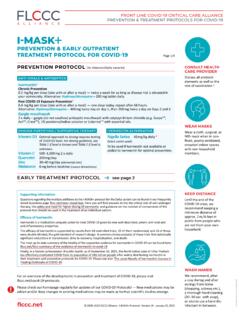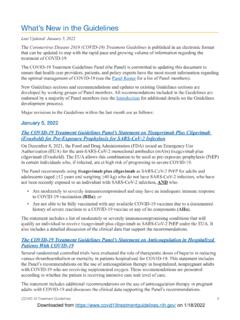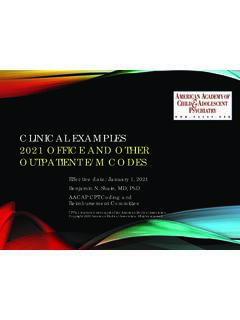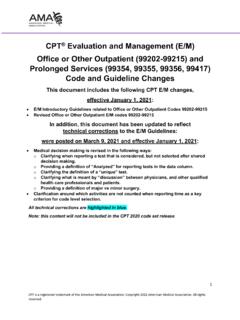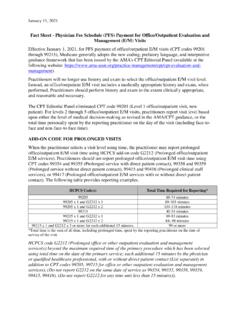Transcription of Outpatient Settings Policy Options
1 Outpatient Settings Policy Options for Improving Infection PreventionNational Center for Emerging and Zoonotic Infectious DiseasesDivision of Healthcare Quality PromotionOctober, 2015 Key Policy Elements for Best PracticesTrainingLicensingReportingInves tigatingKey Policy Elements for Best PracticesiTable of ContentsTable of ContentsExecutive Summary 1 Introduction 3 Facility Licensing/Accreditation 41. Facility Licensing/Accreditation 42. Healthcare Provider Training, Licensure, and Certification 73. Reporting Requirements 124. Investigation Authorities 17 Acknowledgements 21 Appendix I - Policies referenced in key element sections 22 Appendix II - Outpatient Settings worksheets 23 Appendix III - Outbreaks and patient notifications in Outpatient Settings , selected examples.
2 2010-2014 28 Footnotes 33 Outpatient Settings Policy Options for Improving Infection PreventionAbbreviations ListiiASCA mbulatory surgical centerCDCC enters for Disease Control and PreventionCMSC enters for Medicare and Medicaid ServicesFDAFood and Drug AdministrationHAIH ealthcare-associated infectionsHBVH epatitis B virusHCVH epatitis C virusHCWH ealthcare workerHIPAAH ealth Insurance Portability and Accountability ActHIVH uman immunodeficiency virusNHSNN ational Healthcare Safety NetworkAbbreviations ListKey Policy Elements for Best Practices1 Executive SummaryRecent experiences with newly emerging and highly infectious diseases have spotlighted the importance of robust public health and healthcare delivery systems These needs extend across all healthcare Settings and jurisdictions Efforts to define and apply basic standards of infection control in Outpatient healthcare settings1 require bolstering at state, local, territorial and federal levels Current policies are highly variable, leaving many gaps in patient protection from infectious diseases (e g , healthcare-associated infections or HAIs) For example, only a minority of Outpatient facilities are certified by the Centers for Medicare and Medicaid Services (CMS) and few are licensed by states or maintain accreditation status As a result, many of these facilities are opened and operated without being held to minimum safety standards for infection control or other aspects of patient care, potentially putting patients at risk States and their supporting HAI multidisciplinary advisory groups who are interested in more effective and proactive oversight of Outpatient facilities may consider addressing four key elements.
3 (1) facility licensing/accreditation requirements, (2) provider-level training, licensing and certification, (3) reporting requirements, and (4) establishment and effective application of investigation authorities The following sections outline the four key elements recommended by the workgroup and reflect CDC and health department encounters with outbreak investigations,2 as well as feedback from workgroup members based on their experiences and expertise Each section contains an explanation of the element and its components, sample scenarios highlighting the need for effective practices or strategies, potential Options to improve programs, examples of existing state policies, and other aids designed to help states and territories identify gaps and pursue potential solutions at the state, territorial, local, and facility levels 1. Guide to Infection Prevention for Outpatient Settings : Minimum Expectations for Safe Care; Outbreaks and Patient Notifications in Outpatient Settings .
4 This document is designed to assist state, local, and territorial health departments and policymakers at various levels to analyze current policies in Outpatient Settings , review proposed changes, and inspire possible changes to improve Summary2 IntroductionOver the past several decades, healthcare delivery has shifted from the acute, inpatient hospital setting to a variety of ambulatory and community-based Settings CDC recognizes the critical role of public health in patient safety and is interested in identifying barriers and facilitators, including policies that show early promise in reducing HAIs in Outpatient Settings To accomplish this goal, CDC formed a workgroup to obtain input and facilitate the sharing of experiences from state, territorial, local, and tribal health departments that are considering, or have existing policies that address infection control or HAI prevention in Outpatient Settings Ambulatory care is provided in hospital-based Outpatient clinics, nonhospital-based clinics and physician offices, ambulatory surgical centers, and many other specialized Settings Americans frequently receive care in ambulatory Settings , with over three-quarters of all operations in the United States occurring in an Outpatient setting 3 Vulnerable patient populations rely on frequent and intensive use of ambulatory care to maintain or improve their health For example, each year more than one million cancer patients receive Outpatient chemotherapy, radiation therapy, or both 4 It is critical that all of this care be provided under conditions designed to protect patients and save lives by minimizing or eliminating the risk of HAIs or other adverse events Compared to inpatient acute care Settings .
5 Ambulatory care Settings have traditionally lacked infrastructure and resources to support infection control and surveillance activities Physician licensure, while beneficial, is not enough to ensure quality healthcare is delivered and patients are effectively protected Dual licensure of both facilities and healthcare providers has the ability to ensure that healthcare is provided in a safe environment and the quality of care is held to the same standards throughout the state While data describing risks for HAIs are lacking for most ambulatory Settings , numerous outbreak reports5, 6 have described transmission of gram-negative and gram-positive bacteria,7 mycobacteria, viruses8, and parasites 9 This highlights the need for more consistent surveillance data 103. Barie PS. Infection Control Practices in Ambulatory Surgical Centers. JAMA. 2010;303 Halpern MT, Yabroff KR. Prevalence of Outpatient Cancer Treatment in the United States: Estimates from the Medical Panel Expenditures Survey (MEPS).
6 Cancer Investigation. 2008;26 Guh, et al. Patient Notification for Bloodborne Pathogen testing due to Unsafe Injection Practices in the US Health Care Settings , 2001 2011; Medical Care: September 2012 - Volume 50 - Issue 9 - p 785 791. doi: Kuehn, Bridget. Unsafe Injection Practices Plague US Outpatient Facilities, Harm Patients. JAMA. 2012;308(24):2551-2552. Anderson, et al. Invasive Staphylococcus aureus Infections Associated with Pain Injections and Reuse of Single-Dose Vials Arizona and Delaware, 2012; Morbidity and Mortality Weekly Report: July 13, 2012 / 61(27);501-504; 8. Greeley, et al. Hepatitis B outbreak associated with a hematology-oncology office practice in New Jersey, 2009; AJIC: American Journal of Infection Control Volume 39, Issue 8 , Pages 663-670, October 2011. Outbreaks and Patient Notifications in Outpatient Settings ; United States Government Accountability Office. HHS Has Taken Steps to Address Unsafe Injection Practices, but More Action Is Needed.
7 Policy Elements for Best Practices3In many instances, outbreaks and other adverse events11 were associated with breakdowns in basic infection control procedures (e g , reuse of syringes leading to transmission of bloodborne viruses12) All Outpatient healthcare facilities, including physician offices and specialty clinics, might be expected to follow these basic infection control practices at a minimum, regardless of licensure and accreditation status This document is designed to assist state, local, and territorial health departments and policymakers at various levels to analyze current policies in Outpatient Settings , review proposed changes, and inspire possible changes to improve programs The following sections outline key considerations and elements that have been recommended by the workgroup as possible effective Policy or practice strategies to improve the oversight of Outpatient healthcare Settings These sections reflect CDC and health department experiences with outbreak investigations, as well as feedback from workgroup members based on their experiences and expertise Each section contains.
8 An explanation of the element and its components Sample scenarios that highlight the need for effective practices or strategies (additional examples of outbreaks in Outpatient Settings available on the CDC website)14 Potential Options to improve programs Examples of existing state policies representative of the elements Aids designed to help states identify gaps and pursue potential solutions at the state, local, territorial, and facility levels11. Robyn, et al. Notes from the Field: Adverse Events Associated with Administration of Simulation Intravenous Fluids to Patients United States, 2014; Morbidity and Mortality Weekly Report: March 6, 2015 / 64(08);226-227; Guh, et al. Patient Notification for Bloodborne Pathogen testing due to Unsafe Injection Practices in the US Health Care Settings , 2001 2011; Medical Care: September 2012 - Volume 50 - Issue 9 - p 785 791. doi: Guide to Infection Prevention for Outpatient Settings : Minimum Expectations for Safe Care; Outbreaks and Patient Notifications in Outpatient Settings .
9 Settings in particular warrant increased attention from local, territorial, and state health agencies, which are well-positioned to ensure that basic standards of infection control13 are understood and observed consistently across the healthcare Facility Licensing/AccreditationFacility licensure and accreditation requirements can help maintain public safety and ensure quality of healthcare delivery In addition, they also can provide states with the number and type of facilities within their borders and additional influence over these facilities and their activities In some states, facility licensing also acts as a source of revenue for the state health department, and is used to support infection control activities for these facilities Only a minority of Outpatient healthcare facilities are certified by CMS and relatively few are licensed by states or maintain accreditation status As a result, many Outpatient facilities are opened and operated without being held to minimum safety standards for infection control or other aspects of patient care, apart from sanctions and penalties following investigations into the practice This leads to gaps in the ability of state, territorial, and local health departments to monitor and improve healthcare quality and prevent adverse events Regardless of licensure or accreditation, all Outpatient healthcare facilities, including physician offices and specialty clinics, might be expected to follow, at a minimum, basic infection control practices outlined in Standard Precautions.
10 As summarized in the CDC Outpatient Guide 15 More detailed requirements may be applied to certain types of Outpatient Settings based on their scope of practice Outpatient facilities may offer surgical and other invasive procedures without being subject to national infection control standards or any form of on-site inspections In the following example, the absence of facility licensing and accreditation results in a delay in discovering an outbreak, potentially placing patients at risk 15. Guide to Infection Prevention for Outpatient Settings : Minimum Expectations for Safe Care; Beaudoin, Amanda L., et al. Invasive Group A Streptococcus Infections Associated With Liposuction Surgery at Outpatient Facilities Not Subject to State or Federal Regulation ; Morgan, Daniel J., et al. The Gap in Patient Protection for Outpatient Cosmetic Surgery ; A plastic surgery center chain, which does not participate in Medicare or accept other health insurance payments, is unlicensed and unaccredited in the two states where its facilities are located.










